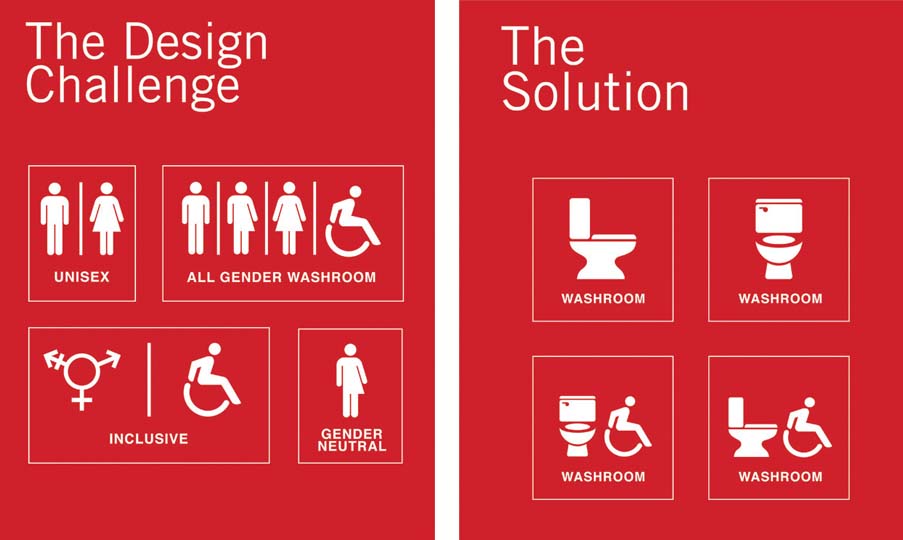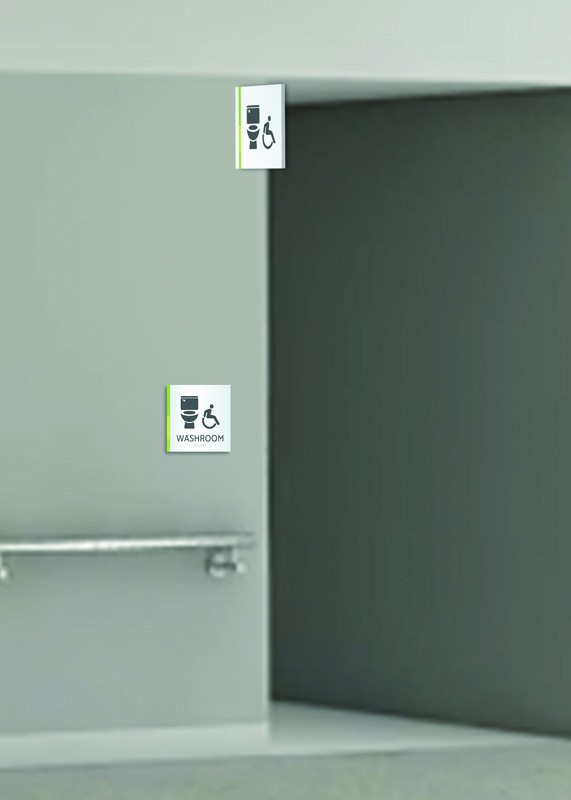
Entro considered a variety of approaches, but found most lacked clarity and/or accuracy. The simplicity of a toilet pictogram provided greater clarity and less chance of exclusion.
Images courtesy Entro
Paying attention to detail
While simplicity is key, attention to detail is also important. Along with language and pictograms, this attention can be signalled through the choice of sign materials.
In the current period of uncertainty and confusion relating to inclusive washrooms, many organizations have understandably implemented temporary signs as they transition to more universal designs. While this is a commendable step forward, a more permanent response, representing greater effort to ensuring the right signage is in place, signals a higher level of care for the public.
Thus, the production of permanent signs for inclusive washrooms should become a priority and be undertaken in a timely manner. And by making sure such details as the pictogram, font, colours and materials fit well with the branding of the surrounding building or organization, a commitment is indicated to the provision of truly inclusive services.
Ultimately, all signs should look professional and be installed with clear intention, representing the efforts behind them.
Wide applicability and consistency
The issue of inclusive washroom signage has often been portrayed in the media and in political discussions as relevant only to members of the LGBTQ community and, more specifically, people who are transgender—yet it actually affects everyone.
The right design can change the experience of anyone who feels excluded by existing washroom situations. One example is when a parent of one gender needs to accompany their child of another gender. This has been a common issue with public washroom access and use for many decades, but recent attention to inclusive washrooms can be of benefit in resolving it.
Indeed, anyone should be able to walk into a hospital or other public venue and know they will not encounter non-inclusive services or signage. With this in mind, it is essential for standards to be created for everyone, so the same signs will be used across all types of facilities, fostering familiarity and allowing individuals who require inclusive washrooms to locate them easily.

The new standard was developed for health-care facilities, but has also inspired active interest from other organizations.
Organizational education
In recognizing there will be a transitional phase for the adoption of such signage, there is a need for education to help shift societal perceptions. Individuals within an organization, including staff, volunteers and patrons, should be given adequate information and resources so they understand the context and the benefits. This will be important not only in explaining why the change is happening, but also—in terms of wayfinding—in encouraging them to provide assistance in the future to any visitors who are looking for inclusive washrooms.
The importance of inclusive design
As exemplified in the new recommendations
for inclusive washroom signage, it will be the responsibility of artists, designers, communicators and other members of the sign design community to recognize societal changes and reflect them in the public assets they create.
In this case, rather than specifically focusing on individuals who do not conform to conventional gender roles, gender was taken entirely out of the equation for sign design; the purpose was not to highlight differences, but rather to create a system that does not rely on such differences. One of the aims was to set a precedent with a new standard that (a) is more representative of an inclusive environment, but (b) requires little explanation.
Companies and other organizations can only more forward on such issues when they have research, recommendations and information drawn from the communities that are most affected. As such, it is important for the sign industry to include these voices and take their experiences into consideration when designing public signage for clients.
“We can’t ignore our understanding of the larger issue at hand,” says Entro’s McCutcheon, “or the impact signage has on everyone who uses it.”
CSA and Entro’s efforts are part of a larger movement to shift the understanding of inclusivity from a convenience to a fundamental human right—and they are already having an effect.
“Recently, one of the hospitals here in Edmonton reached out, saying they had read about the standard and were going to use the signage that was recommended,” says Panas.
In such ways, changes in mainstream public communications and behaviour can result directly from new, evidence-based design recommendations.
Cristina Kelly is a communications and brand strategist for Entro Communications. For more information, visit www.entro.com.





